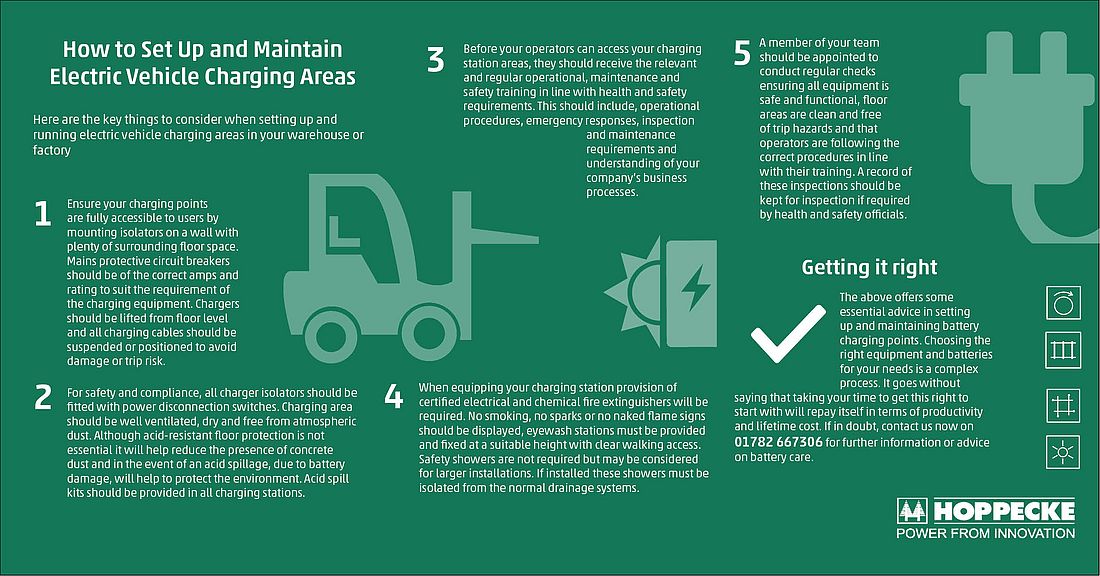Electric warehouse and forklift fleets have some special considerations over and above IC engine vehicles. More than 90 per cent of the UK’s warehouse, logistics and factory fleets are now electric. And the trend to AC power is only accelerating. As we head into a post-Covid, post-Brexit Britain, an electric fleet can offer considerable benefits over diesel or LPG power, in both emissions and overall costs.
Are you involved in setting up a new charging area for forklifts? Or perhaps you could do with a handy checklist to help you manage your existing charging points safely? Or maybe you are considering switching to electric and need some help with what to specify. Whatever your needs, our handy guide can offer you some assistance.
Here are the key things to consider when setting up and running electric vehicle charging areas in your warehouse or factory:
1. Charging Point Installation
Ensure your charging points are fully accessible to users by mounting isolators on a wall with plenty of surrounding floor space. Mains protective circuit breakers should be of the correct amps and rating to suit the requirement of the charging equipment. Chargers should be lifted from floor level and all charging cables should be suspended or positioned to avoid damage or trip risk.
2. Charging Station Requirements and Considerations
For safety and compliance, all charger isolators should be fitted with power disconnection switches. Charging area should be well ventilated, dry and free from atmospheric dust. Although acid-resistant floor protection is not essential it will help reduce the presence of concrete dust and in the event of an acid spillage, due to battery damage, will help to protect the environment. Acid spill kits should be provided in all charging stations.
If you are using this as checklist for existing charger points and stations, make sure you have chosen the correct electrical supply for the chargers. For new charging points please double check that that you have chosen the correct battery capacities for your fleet’s needs.
3. Operators' Preparedness
Before your operators can access your charging station areas, they should receive the relevant and regular operational, maintenance and safety training in line with health and safety requirements. This should include, operational procedures, emergency responses, inspection and maintenance requirements and understanding of your company’s business processes.
4. Safety Equipment
When equipping your charging station provision of certified electrical and chemical fire extinguishers will be required. No smoking, no sparks or no naked flame signs should be displayed, eyewash stations must be provided and fixed at a suitable height with clear walking access. Safety showers are not required but may be considered for larger installations. If installed these showers must be isolated from the normal drainage systems.
5. Frequent Inspections
A member of your team should be appointed to conduct regular checks ensuring all equipment is safe and functional, floor areas are clean and free of trip hazards and that operators are following the correct procedures in line with their training. A record of these inspections should be kept for inspection if required by health and safety officials.
Getting it right
The above offers some essential advice in setting up and maintaining battery charging points. Choosing the right equipment and batteries for your needs is a complex process. It goes without saying that taking your time to get this right to start with will repay itself in terms of productivity and lifetime cost.
Here are just a few more things to bear in mind when specifying electrically powered materials handling equipment:
- - Charging points should be located in well ventilated areas and isolated from any flammable goods.
- - When charging your forklifts, they should be parked allowing unrestricted access to enter and leave the truck, charger stop switches, eye wash stations and fire extinguishers.
- - Provision of all PPE equipment is required to meet with charger point safety requirements. Eye protection goggles or face mask, protective gloves and optional acid resistant apron.
- - Ventilation may be required to maintain hydrogen gas level below 2%. Contact your battery provider for information and calculation.
If in doubt contact the experts
Always remember that for specific advice please contact your battery manufacturer or service provider, especially if you see any error messages, red lights, or your batteries are not recovering. If in doubt, contact us now on 01782 667306 for further information or advice on battery care.
